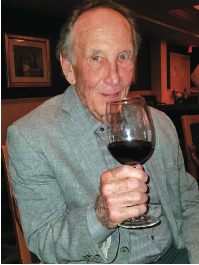S.W AND RICH HERMANSEN
Staff Writers
wine@lbknews.com
Our ongoing field research has exposed us to wine lists that if stacked one atop another would reach the moon. Well, perhaps not the moon but as far as the eye can see.
moon. Well, perhaps not the moon but as far as the eye can see.
Over the years, we have developed strong opinions about what should appear in a wine list. We began thinking seriously about contents of wine lists after attending a wine tasting in which our instructor read the labels on wine bottles; soon after, we wrote up a wine list ourselves for another tasting. We read the label on each bottle that we planned to taste, and we had to decide what to include and exclude. Labels on wine bottles make good starting points for wine lists.
The front label on a bottle of wine has a brand or name that identifies the original vendor of the wine, the grape variety or varieties used to make the wine, the vintage if from one year, and the region where the grapes are grown. A basic wine list includes these facts about the wine and the price for a glass or a bottle or both.
Using a listing of a classic Stags’ Leap wine as an example, the basic information from the front label reads “Stags’ Leap Cabernet Sauvignon Napa Valley 2021. The price at the end of the first line.
A more informative wine list adds to these basics other information from the front and back labels on the bottle and brief tasting notes. Wine bottles sold in the USA must have the percentage of alcohol by volume (ABV %) and warnings about allergens such as sulfites and egg whites. We like to see the ABV in a wine listing. Aside from its value in health and safety, it tells us something more about the degree to which sugars in grape juice have been converted to alcohol. A moderately high ABV, say 14.5%, tells us that the winemaker has converted most of the sugars to alcohol and made a dry wine. We usually prefer dry wine to bring out the flavors of foods and not mask them with sugary tastes. The usual warnings about sulfites pertain to people highly sensitive to allergens because most wines contain sulfites in very low percentages, and egg whites used in fining (clarifying) wines leave only traces in wines. Catchphrases from labels and technical notes pack meaning into a few words. The phrases vary from region to region. The top vineyards in Burgundy France have earned the designation “Grand Cru”, and the slightly lower level “Premiere Cru”. In Bordeaux France the designation applies to Chateau ranging down from Premiere Grand Cru Classe. In California, the wines designated Chateau grown, single vineyard, or region (Napa, Sonoma, Russian River, etc.) generally rate higher than wines that select grapes from wherever in California. Terms such as “Reserve” (longer aged), “Old Vines”, and, of course, “Organic” and “Sustainably Grown” have special meanings.
Tasting notes have a variety of sources: winemakers, reviewers, buyers, distributors, especially valuable tasting by a wine steward. One good example in Sarasota Florida: “Valckenberg Pinot Blanc, ‘21 Rheinhessen Germany $13.00/+
Palest of yellow, exuberant nose of fresh lemons, tart and very dry on the palate, with green apples and citrusy notes, long finish with slight lingering bitterness”.
Block 15 Cork and Craft, 1528 Main Street.
The nearby Vino Bistro of Sarasota at 1419 5th Street in the Rosemary District captures the tastes of a wine in a few words: Janela Branca – Special Selection. Smooth Portuguese red with ripe berry fruit, a touch of spice, and soft tannins.
Wine lists, both in print and on the web, have a key role in connecting wine drinkers to the cellar of a wine bar or restaurant. Key terms from the label and winemaker and reviewer notes, plus accurate and enticing tasting notes, make a better wine list.
S. W. Hermansen has used his expertise in econometrics, data science and epidemiology to help develop research databases for the Pentagon, the National Institutes of Health, the Department of Agriculture, and Health Resources and Services. He has visited premier vineyards and taste wines from major appellations in California, Oregon, New York State, and internationally from Tuscany and the Piedmont in Italy, the Ribera del Duero in Spain, the Barossa Valley and McLaren Vale in Australia, and the Otego Valley in New Zealand. Currently he splits time between residences in Chevy Chase, Maryland and St. Armand’s Circle in Florida.
Rich Hermansen selected has first wine list for a restaurant shortly after graduating from college with a degree in Mathematics. He has extensive service and management experience in the food and wine industry. Family and friends rate him as their favorite chef, bartender, and wine steward. He lives in Severna Park, Maryland.

